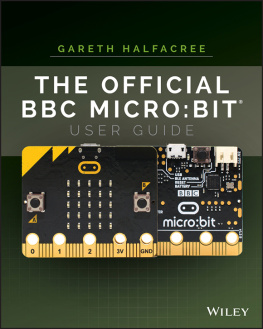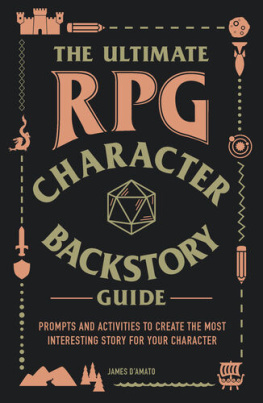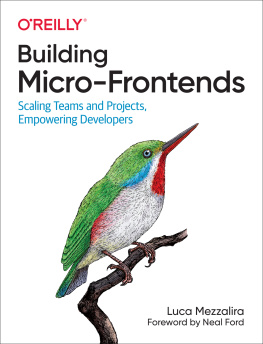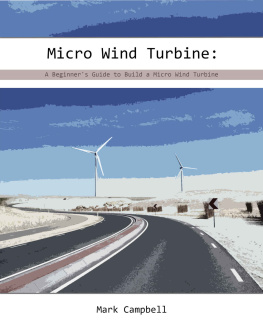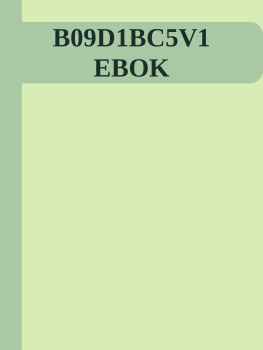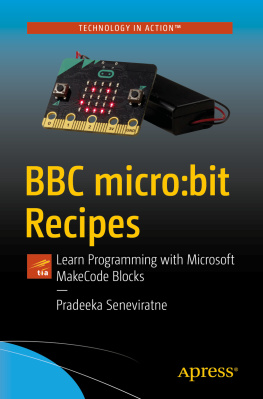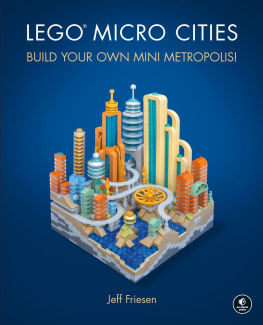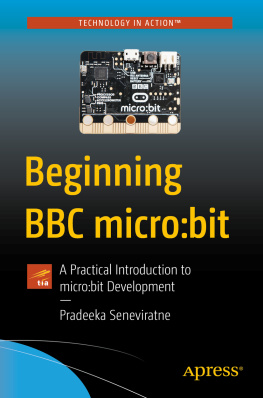

The Official BBC micro:bit User Guide
Published by
John Wiley & Sons, Inc.
10475 Crosspoint Boulevard
Indianapolis, IN 46256
www.wiley.com
Copyright 2018 by John Wiley & Sons, Inc., Indianapolis, Indiana
Published simultaneously in Canada
ISBN: 978-1-119-38673-5
ISBN: 978-1-119-41376-9 (ebk)
ISBN: 978-1-119-41384-4 (ebk)
No part of this publication may be reproduced, stored in a retrieval system or transmitted in any form or by any means, electronic, mechanical, photocopying, recording, scanning or otherwise, except as permitted under Sections 107 or 108 of the 1976 United States Copyright Act, without either the prior written permission of the Publisher, or authorization through payment of the appropriate per-copy fee to the Copyright Clearance Center, 222 Rosewood Drive, Danvers, MA 01923, (978) 750-8400, fax (978) 646-8600. Requests to the Publisher for permission should be addressed to the Permissions Department, John Wiley & Sons, Inc., 111 River Street, Hoboken, NJ 07030, (201) 748-6011, fax (201) 748-6008, or online at http://www.wiley.com/go/permissions .
Limit of Liability/Disclaimer of Warranty: The publisher and the author make no representations or warranties with respect to the accuracy or completeness of the contents of this work and specifically disclaim all warranties, including without limitation warranties of fitness for a particular purpose. No warranty may be created or extended by sales or promotional materials. The advice and strategies contained herein may not be suitable for every situation. This work is sold with the understanding that the publisher is not engaged in rendering legal, accounting, or other professional services. If professional assistance is required, the services of a competent professional person should be sought. Neither the publisher nor the author shall be liable for damages arising herefrom. The fact that an organization or Web site is referred to in this work as a citation and/or a potential source of further information does not mean that the author or the publisher endorses the information the organization or website may provide or recommendations it may make. Further, readers should be aware that Internet websites listed in this work may have changed or disappeared between when this work was written and when it is read.
For general information on our other products and services please contact our Customer Care Department within the United States at (877) 762-2974, outside the United States at (317) 572-3993 or fax (317) 572-4002.
Wiley publishes in a variety of print and electronic formats and by print-on-demand. Some material included with standard print versions of this book may not be included in e-books or in print-on-demand. If this book refers to media such as a CD or DVD that is not included in the version you purchased, you may download this material at http://booksupport.wiley.com . For more information about Wiley products, visit www.wiley.com .
Library of Congress Control Number: 2017950180
Trademarks: Wiley and the Wiley logo are trademarks or registered trademarks of John Wiley & Sons, Inc. and/or its affiliates, in the United States and other countries, and may not be used without written permission. Micro:bit is a registered trademark of the British Broadcasting Corporation. All other trademarks are the property of their respective owners. John Wiley & Sons, Inc. is not associated with any product or vendor mentioned in this book.
For my father, the enthusiastic past, and my daughters,
the exciting future.
Gareth
About the Author
GARETH HALFACREE is a freelance technology journalist and the co-author of the Raspberry Pi User Guide alongside project co-founder Eben Upton. Formerly a system administrator working in the education sector, Gareth's passion for open source projects has followed him from one career to another, and he can often be seen reviewing, documenting or even contributing to projects such as GNU/Linux, LibreOffice, Fritzing and Arduino. He is also the creator of the Sleepduino and Burnduino open hardware projects, which extend the capabilities of the Arduino electronics prototyping system. A summary of his current work can be found at http://freelance.halfacree.co.uk .
About the Technical Editor
DAVID WHALE is an embedded software engineer whose career of over 30 years has involved him designing and building embedded software for a diverse collection of high tech products. David is a STEM Ambassador and volunteer for the Institution of Engineering and Technology (IET), where he regularly helps schools and teachers introduce and run computing clubs, as well as trains teachers nationally. It was through his association with the IET that David became involved with the micro:bit project, where he has helped to develop a large base of teaching resources, as well as train and support the delivery of the IET Faraday national STEM challenge days using the BBC micro:bit. David now works with the Micro:bit Educational Foundation, where he continues to develop projects and resources with many partner organisations, which includes the Doctor Who team at the BBC. David is the co-author of the successful Wiley title Adventures in Minecraft, a book that teaches Python coding to children via their interest in the Minecraft game, and he has been technical editor of a wide range of technology and computing books.
Credits
Project Editor
John Sleeva
Technical Editor
David Whale
Production Editor
Barath Kumar Rajasekaran
Copy Editor
Karen A. Gill
Production Manager
Katie Wisor
Manager of Content Development and Assembly
Mary Beth Wakefield
Marketing Manager
Christie Hilbrich
Professional Technology & Strategy Director
Barry Pruett
Business Manager
Amy Knies
Executive Editor
Jody Lefevere
Associate Acquisitions Editor
Riley Harding
Project Coordinator, Cover
Brent Savage
Proofreader
Debbye Butler
Indexer
Estalita M. Slivoskey
Cover Designer
Wiley
Cover Image
Courtesy of Gareth Halfacree
The Official BBC micro:bit User Guide
- Table of Contents
Guide
Pages
Foreword
IN APRIL 2015, I spent a lunchbreak searching my local supermarket for the cheapest thing I could cannibalise to finish a demo for the BBC. What they saw that afternoon was the battery clip from a 1 alarm clock, glued onto an early BBC micro:bit prototype. I was building a demo as one of the 31 partner organisations that the BBC had recruited to help them deliver a bold and audacious project: to give a coding device to every year 7 in the UK, for free. However, the BBC micro:bit wasnt designed to be just another programmable development board, but a seamless plug-and-play tool that puts creativity, learning, and ease-of-use for teachers and young people first.
As an engineer on the project, the most compelling thing about working with the BBC micro:bit is seeing the exciting (and sometimes ridiculous) things these new audiences choose to do with this technology: build a team game based on a teleporting duck, measure a rocket cars acceleration, tell the interactive story of pizza, build a portable heart-rate-monitor, or invent the fantastic rain detecting hat you can find in this book. This guide brilliantly captures the exhilaration, simplicity, and creative potential of the BBC micro:bit, and Im sure it will help many more people become coders and inventors.
Next page
